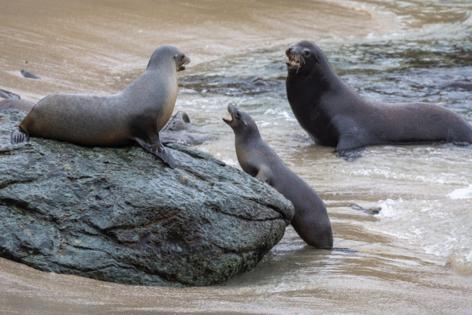Outbreak of kidney disease is killing sea lions in California. Here's why humans should be concerned
Published in News & Features
LOS ANGELES — As summer heats up and tourists flock to the California coast, beachgoers should be on the lookout for sea lions sickened by a recent outbreak of leptospirosis — a kidney disease that can result in severe symptoms in both humans and animals.
The Marine Mammal Center in Sausalito has reported a significant outbreak of leptospirosis in California sea lions since early July, affecting animals primarily in Central and Northern California, according to the center’s public relations director, Giancarlo Rulli.
Leptospirosis is a bacterial disease that causes kidney failure in marine mammals — notably, California sea lions, Rulli said. The Marine Mammal Center has responded to more than 200 sea lions that have shown symptoms, with 150 of those since the beginning of July.
Humans can get leptospirosis, contracting the illness through water or soil contaminated by the urine of infected animals. Symptoms in humans may include fever, headache, muscle aches, jaundice, vomiting, diarrhea and skin rash. The disease is typically treated with antibiotics.
The disease can be fatal in dogs, and because it’s transmitted through contaminated water, it’s especially concerning at the beach, according to Rulli. Experts have advised pet owners to keep their dogs leashed when they’re near the shoreline and not to approach any marine mammal. Pet owners should also contact their local veterinary clinic to see if there’s a leptospirosis vaccine available for their dogs.
The disease can spread among species, but in California sea lions, it is primarily transmitted through bodily fluids, particularly urine. About two-thirds of the California sea lions that the center responds to will die in transport or during care, or have to be euthanized after an admission exam.
“Leptospirosis is an extremely virulent disease,” Rulli said. “There is a high mortality rate in California sea lions. By the time a sea lion washes ashore, they are experiencing mass inflammation. They may already have active kidney failure, so there is a major uphill challenge in terms of veterinary care to give these animals a second chance and release them back out to the wild.”
Historically, outbreaks of this disease have occurred every three to five years, but since 2018, they have become more frequent.
From late 2012 until 2017, there was a “warm weather blob” that extended from the waters off the west coast of Mexico all the way to the Gulf of Alaska. During that time, leptospirosis nearly disappeared among the sea lion population, Rulli said. It then kicked back up in 2018, when the Marine Mammal Center responded to more than 300 cases of sickened sea lions. Since then, outbreaks have been occurring more consistently.
Signs of leptospirosis in sea lions include tightly tucked front flippers, severe lethargy and the animals drinking water. Although sea lions and most other marine mammals normally get all of their hydration from the fish or food they consume, a sickened sea lion has extreme thirst due to inflammation within the body, so it is a cause for concern when the animals are seen drinking water.
Once the sea lions are brought in for treatment, they receive a full exam and a series of diagnostic tests on blood, urine and other samples, according to Rulli. Ultrasound allows experts to look at the kidneys to determine the severity of the disease. The animals are treated with a mix of antibiotics, gastroprotectants to address stomach ulcers, and bagged fluids to help stabilize the kidneys. It can take a few weeks to a few months for the animal to recover.
_____
©2025 Los Angeles Times. Visit at latimes.com. Distributed by Tribune Content Agency, LLC.







Comments